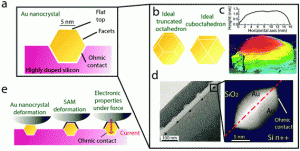Whilst undertaking my PhD I was repeatedly warned that the synthesis of nanoparticles was a ‘dark art’ i.e. luck. When, in fact, synthesising these particles actually turned out to be the easy part, whilst the most difficult parts were attempting to achieve stable nanoparticle systems and understanding their resulting properties.
Even as the field of nanotechnology has undergone considerable expansion there still remain many unanswered fundamental questions. One such question is whether the mechanical and electrical properties of gold nanoparticles are representative of those of the bulk material and how these properties become modified in the presence of an organic coating layer.
Smaali and co-workers have tackled this issue by performing quantitative analysis on the mechanical and electrical properties of thiolated gold nanocrystals. Utilising a recently published procedure, single nanoparticles were grown in a silicon bed with an alkyl-thiol coating on one side and an ohmic contact on the other. To investigate the properties of these nanoparticles, a conducting atomic force microscope (AFM) tip was used, primarily as it offered the ability to interact with the nanocrystals using a variable loaded force with high precision, but also, due to the presence of an ohmic contact, the electrical properties of the nanocrystals and the alkyl-thiol coating could be tested.
Employing AFM measurements and finite elemental analysis (FEA) simulations, the Youngs Modulus of the embedded single nanocrystals was estimated to be 4 times smaller than those of free standing single nanocrystals. The molecular junctions formed between the thiol SAM coating and the individual nanoparticles provided an interesting insight into electronic properties of these materials, with a significant decrease in the tunnel current decay factor and potential barrier height being measured when forces even in the low nN range were applied. These results have been substantiated through FEA and DFT calculations to be a result of strain-induced molecular deformation, which causes a significant impact on the interfacial dipole, resulting in a change in the HOMO position with respect to the Au Fermi energy.
The authors of this study predict that this research could be used as a base model for other studies of functional molecular junctions and mechanical switches, with even small changes in van der Waals forces of a few nN thought to be sufficient to change the electron properties of nanoparticle-based molecular electronic devices.
On the mechanical and electronic properties of thiolated gold nanocrystals
K. Smaali, S. Desbief, G. Foti, T. Frederiksen, D. Sanchez-Portal, A. Arnau, J. P. Nys, P. Leclère, D. Vuillaume and N. Clément
Nanoscale, 2015, 7, 1809-1819. DOI: 10.1039/C4NR06180B
Dr Derek Craig is a guest web writer for the Nanoscale blog. He is a Post Doctoral Research Fellow at the University of St. Andrews based in the fields of Biophotonics and Materials Science. With a background in chemistry, his work mainly focuses on the synthesis of nano to meso materials and the use of imaging techniques to study biological samples.











